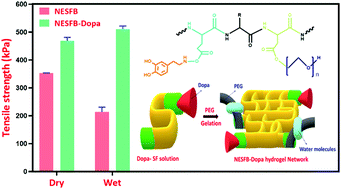A dopamine-functionalized aqueous-based silk protein hydrogel bioadhesive for biomedical wound closure†
Abstract
Silk fibroin (SF) from Bombyx mori is a natural macromolecule with remarkable biocompatibility and adhesive ability. For wound healing bio-adhesive applications, good biodegradability is essential. The ideal bio-adhesive is expected to be fixed together in the early stage of wound healing, adhere to tissues to avoid cracking, and present slow and favorable degradation at the wound site after healing. The residual adhesive component should be completely degraded after the wound has healed either through being absorbed by the body or excreted through the biological metabolism. Herein, SF was functionalized with dopamine through a one-step method with crosslinkers to enhance its adhesive ability. Poly(ethylene glycol) (PEG) was selected to optimize the gelation time (NESFB-Dopa). The ratio of SF and PEG, the ratio of crosslinker, the amount of dopamine and the adhesive environment were tuned to determine the optimal conditions. Following the ASTM standard, when the weight ratio of SF to PEG was 5 : 5, the molar ratio of NHS to EDC was 2 : 1, and the content of dopamine was 5 weight%; also, the tensile strength of NESFB-Dopa achieved greater values of 460.44 ± 18.45 kPa and 503.32 ± 16.54 kPa in dry and wet conditions, respectively, which demonstrated superior adhesive properties compared with those of the clinically used fibrin sealants.



 Please wait while we load your content...
Please wait while we load your content...